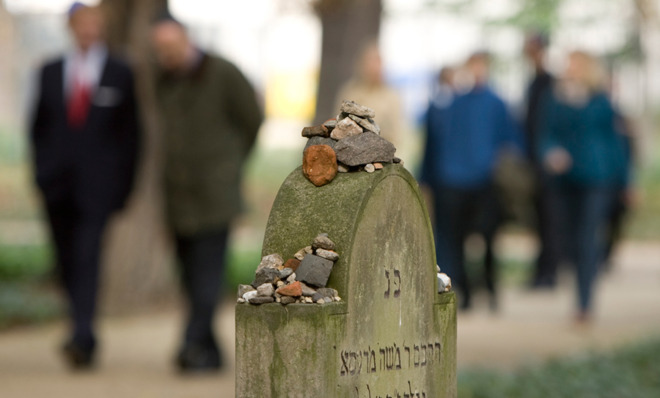What's the proper way to bury a Nazi?
The discovery of Heinrich Müller's burial site illuminates the difficulties of handling Nazi remains

The body of Gestapo chief Heinrich Müller has apparently been lying peacefully in a Jewish cemetery in the heart of Berlin ever since World War II.
Müller was the only Nazi bigwig whose fate was never definitively established. One of the architects of the Holocaust — he was at the Wannsee Conference where the Nazis came up with their plan to gas to death Europe's Jews — he would have been a top prize at the Nuremberg trials, only nobody knew what had happened to him. He was last reported seen in Hitler's bunker on May 1, 1945, the day after Hitler killed himself.
Now, Germany's biggest tabloid, Bild, says that new research shows Müller was killed that day and buried in a provisional grave. A few months later, his remains were transferred to a mass grave in a Jewish cemetery in the Mitte borough of Berlin. Scholar Johannes Tuchel says he has a document stating that in 1963, a gravedigger told West German local police that he had reburied Müller all those years ago. By then, though, the Berlin Wall was up and the West German authorities couldn't get at the cemetery in East Berlin, so they dropped the matter.
The Week
Escape your echo chamber. Get the facts behind the news, plus analysis from multiple perspectives.

Sign up for The Week's Free Newsletters
From our morning news briefing to a weekly Good News Newsletter, get the best of The Week delivered directly to your inbox.
From our morning news briefing to a weekly Good News Newsletter, get the best of The Week delivered directly to your inbox.
Jewish groups are appalled. "I can't think of a worse desecration of a Jewish cemetery than to bury Heinrich Müller there," Efraim Zuroff, chief Nazi hunter of the Simon Wiesenthal Center, told The New York Times.
Nazis are not buried in marked graves, for an obvious reason: Neo-Nazi groups might create shrines around them and use them as rally sites. So what do you do, exactly, with a dead Nazi? Here's how Hitler and his top henchmen were disposed of:
Hitler and Goebbels
Hitler shot himself in his bunker as the Soviet Red Army was marching into Berlin. His minions followed his instructions and burned his body in the garden of the Reich Chancellery in Berlin. Just two days later, Soviet intelligence retrieved the remains and buried them, along with the remains of Nazi propaganda chief Joseph Goebbels, who had also killed himself, and his family. The Soviets moved the remains to a secret burial site in Magdeburg, Germany, but then in 1970, when Soviet authorities were due to hand over that area to East German authorities, the KBG dug up all the charred bodies, burned them again, and dumped the ashes into Germany's Biederitz River.
A free daily email with the biggest news stories of the day – and the best features from TheWeek.com
Heinrich Himmler
The head of the SS was captured by the British at the end of the war while attempting to flee. Before he was to be interrogated, he chomped down on a cyanide capsule hidden in his mouth and died. Four British soldiers buried him secretly in an unmarked spot on Lüneburg Heath, a vast moor in northern Germany. They were sworn to secrecy under the Official Secrets Act, and their files are under seal until 2045. It is rumored that a cross was set up on the heath the following year, and the British dug in that area but found no remains.
Josef Mengele
Sadistic physician Josef Mengele, known as the "Angel of Death" for conducting brutal experiments on living concentration camp prisoners, escaped to South America after the war and lived on the lam for 34 years. He practiced medicine in Argentina before moving to Paraguay and eventually Brazil. He died in 1979 after suffering a stroke while swimming, and his family buried him in a suburb of São Paulo under the name Wolfgang Gerhard. Those remains were exhumed in the 1980s, and DNA tests in 1992 confirmed they were his. After the tests were done, Brazilian authorities cremated the bones, but Mengele's descendents refused to claim the ashes, so they are evidently still being stored at the São Paulo Institute for Forensic Medicine.
Rudolf Hess
This is the reason why you don't want Nazi grave sites. Hess, the deputy Fuhrer, was captured in Britain in 1941 when he flew there solo to try to negotiate a peace. Sentenced to life in prison at Nuremberg, he killed himself in Berlin's Spandau prison in 1987, when he was 93. He was buried in Wunsiedel, a town in southern Germany, and his gravestone bore the words Ich bin's gewagt, or "I dared." Every year on the anniversary of his death, hordes of neo-Nazis marched to the cemetery and attempted to rally, only to be turned back by police. Finally in 2011 the church canceled the family's lease on the grave, and Hess's remains were exhumed, cremated, and scattered at sea. The gravestone was destroyed.
Susan Caskie is The Week's international editor and was a member of the team that launched The Week's U.S. print edition. She has worked for Radio Free Europe/Radio Liberty, Transitions magazine, and UN Wire, and reads a bunch of languages.
-
 Homes by renowned architects
Homes by renowned architectsFeature Featuring a Leonard Willeke Tudor Revival in Detroit and modern John Storyk design in Woodstock
-
 Looming drone ban has farmers and farm-state Republicans anxious
Looming drone ban has farmers and farm-state Republicans anxiousIN THE SPOTLIGHT As congressional China-hawks work to limit commercial drone sales from Beijing, a growing number of conservative lawmakers are sounding an agricultural alarm
-
 Mind-expanding podcasts you may have missed this fall
Mind-expanding podcasts you may have missed this fallThe Week Recommends True crime, a book club and a therapeutic outlet led this season’s best podcasts